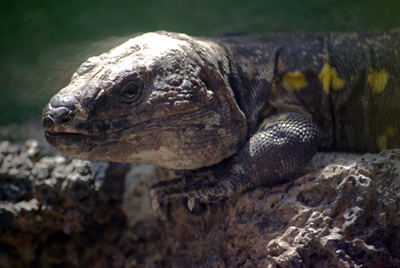 The path down to El Pozo de las Calcosas
The path down to El Pozo de las CalcosasAlthough El Hierro only has one real beach, it has a lot of natural inlets which have been developed as natural, salt-water swimming pools
 The summer houses
The summer houses"Developed" sounds dodgy, I know, but all the ones I've seen really have been improved by the process. They build a path so you can walk down to the shore instead of slithering down and turning your ankle. They add some steps or ladders so you can get in and out of the water without scraping your knee. And they level off a few patches for comfortable sunbathing. If they're feeling ambitious, they might add a barbecue area or smooth off the bottom of one of the pools to make it toddler-friendly. But all the concrete is the same colour as the natural rock, so you have to look twice to see which is which.
 The statue of Neptune by Ruben Armiche
The statue of Neptune by Ruben ArmicheNot so very long ago, most Herreñens were goat herds, and it was quite normal for a family to have two or three houses -- all right, two or three hovels -- because they had to go wherever the pasture was. Today, lots of family have converted one of the hovels into a beach hut, even if they aren't rich. Frequently, the whole family moves in for the school summer holidays. And if someone in the family is good at DiY, the beach hut gradually morphs into a very nice cottage.
 The swimming pools
The swimming poolsEl Pozo de las Calcosas has a lot of these beach huts and cottages, near two swimming pools. It's also got a lovely statue of Neptune by local artist Ruben Armiche, just beside the path up to the car park.
I had a very nice paddle in the shallow pool, and spent ages trying to get a decent photo of the crabs down by the surf. They were as uncooperative as cats, but I was pretty determined about it.
And then I had to walk back up all those steps.
 Crabs in the surf
Crabs in the surf





































